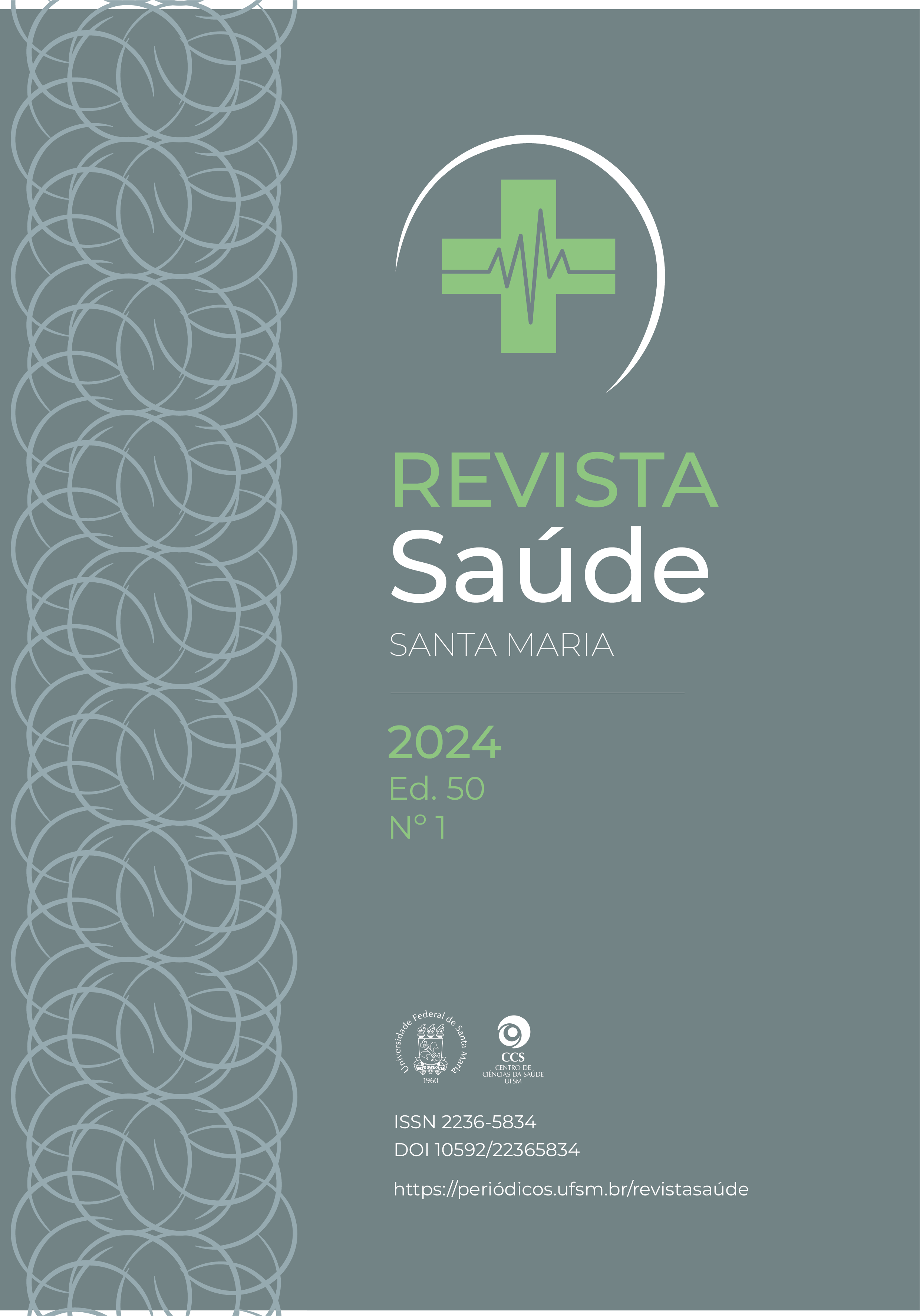Prevalence of breastfeeding of children attended at a basic health unit in the periphery of a capital in southern Brazil
DOI:
https://doi.org/10.5902/2236583471658Keywords:
Breast feeding, Unified health system, Child nutritionAbstract
Objectives: analyze the prevalence rate of exclusive breastfeeding (EBF) up to the sixth month of age and what was introduced early in the diet of children. Methods: Cross-sectional study carried out with 30 mothers of children. Sociodemographic data, prenatal care and breastfeeding and food introduction data were collected during a home visit. Results: Of mothers' children included, 17 were male (56.7%) and the mothers' age presented a mean of 25.5±5.8 years. Regarding data related to the birth of children, 83.3% had six or more prenatal consultations. Almost two-thirds of children were breastfed within the first hour of life. The early introduction of liquids before six months was considerably higher than the early introduction of solid foods (p<0.05), the main ones being water and other milks. Regarding EBF both at four months of life and at six months, a positive significant association was found with the fact that the child had been breastfed in the first hour of life (p<0.05). Conclusions: The prevalence of EBF up to six months of the child's life was only 24%, since there was an early introduction, mainly of liquids. The fact that the child was breastfed in the first hour of life was positive for the maintenance of the EBF.
Downloads
References
White JM,Bégin F,Kumapley R, Murray C,Krasevec J.Complementary feeding practices: Current global and regional estimates. Matern Child Nutr.2017;13(Suppl 2):e12505.
WHO (World Health Organization). Infant and young child feeding. Genebra, 2021.
Victora CG, Barros AJD, França GVA, Bah R, Rollins NC, Horton S, Krasevek J, Murch S, Sankar MJ, Walker N. Amamentação no século 21: epidemiologia, mecanismos e efeitos ao longo da vida. Epidemio Serv Saúde. 2016;2(1):1–24.
United Nations Children's Fund (UNICEF). Global Breatsfeeding Scorecard. New York; 2019.
Del Ciampo JA, Del Ciampo IRL. Breastfeeding and the Benefits of Lactation for Women's Health. Rev Bras Ginecol Obstet. 2018;40(6):354-359.
Hossain S, Mihrshahi S. Exclusive Breastfeeding and Childhood Morbidity: A Narrative Review. Int J Environ Res Public Health. 2022;19(22):14804.
Quesada JA, Méndez I, Martín-Gil R. The economic benefits of increasing breastfeeding rates in Spain. Int Breastfeed J. 2020;15(1):34.
Brasil. Ministério da Saúde (MS).Saúde da criança: aleitamento materno e alimentação complementar. Brasília: MS; 2015.
World Health Organization (WHO). Indicators for assessing infant and young child feeding practices: conclusions of a consensus meeting held. Washington, DC; 2007.
Brasil. Ministério da Saúde (MS). Pré-natal e puerpério: atenção qualificada e humanizada: manual técnico. Brasília: MS; 2006.
Spadea T, Rusciani R, Mondo L. Inequalities in prenatal care and pregnancy outcomes in Piedmont Region (Northern Italy). Epidemiol Prev. 2020;44(5-6 Suppl 1):127-135.
Osawa E, Kodama T. Regional socio-environmental characteristics associated with inadequate prenatal care during pregnancy: an ecological study of 47 prefectures in Japan. BMC Pregnancy Childbirth. 2021;21(1):619.
Tavares MC, Aires JS, Dodt RCM, Joventino ES, Oriá MOB, Ximenes LB. Application of Breastfeeding Self-Efficacy Scale-Short Form to post-partum women in rooming-in care: a descriptive study. Online Brazilian Journal of Nursing. 2010;9(1).
Viellas EF, Domingues RMSM, Dias MAB, Gama SGN, Theme Filha MM, Costa JV, Bastos MH, Leal MC. Assistência pré-natal no Brasil. Cad Saúde Pública. 2014;30(Suppl 1):S85-S100.
Costa RC, Campos MOC, Marques LARV, Rodrigues Neto EM, Franco MC, Diógenes, ESG. Diabetes gestacional assistida: perfil e conhecimento das gestantes. Saúde (Santa Maria). 2015;41(1):131–40.
Brasil. Ministério da Saúde (MS). Secretaria de Atenção à Saúde. Departamento de Ações Programáticas e Estratégicas. Pesquisa de prevalência de aleitamento materno em municípios brasileiros: situação do aleitamento materno em 227 municípios brasileiros. Brasília; 2010.
Alves JS, Oliveira MIC, Roto RVVF.Orientações sobre amamentação na atenção básica de saúde e associação com o aleitamento materno exclusivo. Ênc Saúde Colet. 2018;23(4):1077-88.
Ricci C, Otterman V, Bennett T-L, Metcalfe S, Darling E, Semenic S, et al. Rates of and factors associated with exclusive and any breastfeeding at six months in Canada: an analysis of population-based cross-sectional data. BMC Pregnancy Childbirth. 2023;23(1):56.
Moore ER, Anderson GC, Bergman N, Dowswell T. Early skin-to-skin contact for mothers and their healthy newborn infants. Cochrane Database Syst Rev. 2012;(5):CD003519.
Moore ER, Bergman N, Anderson GC, Medley N. Early skin-to-skin contact for mothers and their healthy newborn infants. Cochrane Database Syst Rev. 2016;11:CD003519.
Silva JLP, Linhares FMP, Barros AA, Souza AG, Alves DS, Andrade PON. Factors associated with breastfeeding in the first hour of life in a baby-friendly hospital. Texto contexto - enferm. 2018;27(4):1-9.
Lopes WC, Marques FKS, Oliveira FC, Rodrigues JA, Silveira MF, Caldeira AP, Pinho L. Alimentação das crianças nos primeiros anos de vida. Rev Paul Pediatr. 2018;36(2):164-70.
Arredondo A, Lugo OBR, Orozco E, de la Rosa CPT. Breastfeeding and feeding practices in the first year of life and its association with overweight and obesity of children in Mexico. Ver Bras Saúde Mater Infant. 2021;21(4):1109-18.
Jacqueline Castenmiller J,Henauw S,Hirsch‐Ernst K-I, Kearney J,Knutsen HK, Alexandre Maciuk A, et al. Appropriate age range for introduction of complementary feeding into na infant's diet. EFSA J. 2019;17(9):e05780.
Bailey RL, Stang JS, Davis TA, Naimi TS, Schneeman BO, Dewey KG, et al. Dietary and Complementary Feeding Practices of US Infants, 6 to 12 Months: A Narrative Review of the Federal Nutrition Monitoring Data. J Acad Nutr Diet. 2022;122(12):2337-2345.
D'Auria E, Borsani B, Pendezza E, Bosetti A, Paradiso L, Zuccotti GV, Verduci E. Complementary Feeding: Pitfalls for Health Outcomes. Int J Environ Res Public Health. 2020;17(21):7931.
Piro SS, Ahmed HM. Impacts of antenatal nursing interventions on mothers' breastfeeding self-efficacy: an experimental study. BMC Pregnancy Childbirth. 2020;20(1):19.
Downloads
Published
How to Cite
Issue
Section
License
Copyright (c) 2024 Andréia Ferlini da Cunha, Luiza Vigne Bennedetti, Priscila Berti Zanella, Bruna Lisboa Mendes dos Santos

This work is licensed under a Creative Commons Attribution-NonCommercial-NoDerivatives 4.0 International License.
A Declaração de Direito Autoral e os itens a serem observados podem ser visualizados no seguinte link: http://cascavel.ufsm.br/revistas/ojs-2.2.2/index.php/seculoxxi/information/sampleCopyrightWording





